Explore the beauty of Kinbaku – a traditional Japanese rope bondage artform. Learn rope techniques and enhance your BDSM experiences today.
Kinbaku, the Art of Rope Bondage.
While the use of ropes in the BDSM world is nothing new, a practice of rope tying focusing on both restraint and beauty has been increasing in popularity.
Originating from Japan it has well and truly made its way to the west and it has everyone very interested.
I will explain Kinbaku and its origins, discuss the rope types preferred by Kinbaku enthusiast. And show you some introductory techniques to get you started.
What Is Kinbaku?
Meaning “The Beauty of Tight Binding”. It is a Japanese style of BDSM or bondage that uses thin rope to tie people up while also creating visually intricate patterns.
This means that many different lengths of rope are required to achieve the desired look. Couple this with the need for knot knowledge and Kinbaku becomes something that requires a bit of investigation and a lot of practice.
Is there a difference between Kinbaku and Shibari?
Shibari refers to a purely artistic use of the rope play that is much more focused on the overall look of the ropes on the body. It isn’t considered sexual.
Kinbaku does focus more on the restraint aspect of the rope in both the physical and mental realm.
If you walk into an Adultsmart Lifestyle Centre and ask about either Kinbaku or Shibari we will know what you are referring to. Terms are becoming increasingly interchangeable.

Origins of Kinbaku Rope Bondage
Kinbaku in one form or another has been around for a very long time. And first came to be noticed during the late Edo period of Japan (1600’s – 1860’s).
It is thought the practice originated with Seiu Ito who is known as the father of Kinbaku. He drew inspiration for the practice from Hojojutsu (a form of martial arts that employs rope as restraints) as well as Kabuki Theatre and Wood carvings.
It’s popularity increased in Japan during the 1950’s when adult magazines began publishing the practice. Soon after live shows followed allowing people to experience Kinbaku in person.
When Kinbaku made its way to the west it began to influence BDSM practices here. It is highly likely that BDSM fans have come across Kinbaku at one stage.
Kinbaku is now regularly used in tandem with other bondage practices creating a plethora of different types and fusions.
Rope Types
Now while it may seem like you can just grab some rope from the nearest garden shed or hardware store and get started but this really isn’t the case.
Rope isn’t just rope in Kinbaku.
It is your tool, your artwork so picking the correct type is always important.
Traditionally a loose laid, three strand jute rope is used. They’re called this Asanawa which is translated as “hemp rope.” Hemp was the first fibre used. Generally it is considered to refer to a range of natural fibre ropes rather than a specific type.
And while traditionalists will still use this type. We now have a range of ropes made from both synthetic and natural products that will work well.
-
Natural Fibre Ropes
This rope was and is still used has to do with the flexibility of the fibres. They bend with the body but can still hold tension.
Creating friction which not only helps to hold the knots together but also creates an interesting sensation against the skin.
-
Silk Ropes
Typically manufactured in the traditional style (loose laid 3 strand) silk ropes offer a softer alternative against the skin.
-
Synthetic Ropes
Again designed similarly, they offer another alternative.
Generally smoother than natural fibre, synthetic ropes are a good alternative for those wanting something a little more rough than silk. But not as coarse as natural.
- Choosing a Type of Rope
A general rule with choosing rope is to consider what you are planning to do with it especially with regards to length.
Kinbaku can use up a long length of rope up quickly because of the tying styles. It is also important to think of who and where it is going. Wrists and ankles are likely to be less sensitive than thigh skin.
Flexibility is also important in the rope. It gives greater control of tightness and resistance while still allowing movement.

Basic Techniques
Two basic knots that you need to know are:
-
Bowline Knot
This will not slip and is suitable for single limb bondage and suspension.
-
Square (or Reef) Knot
One worth knowing. It can be used for just about anything and doesn’t slip meaning that it can tolerate movement and the struggling of the captive.
Once you have mastered these two knots jump into some research.
Learn different variations and styles of those knots as well as other tying techniques that build on either the square or bowline knots.
Below are some images of a glimpse into the popular BDSM restraint system Japanese Rope Bondage
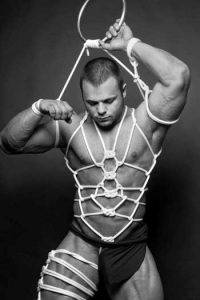
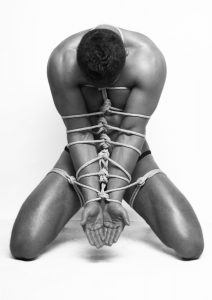
A Model’s Glimpse Into Japanese Rope Bondage
I have been privileged to be the subject in some intimate Sydney exhibitions in the art of Shibari and Kinbaku. An almost indescribable feeling.
There is euphoria, relaxation, arousal, and intimacy in eye contact with the rope master while the rope was softly stroking my bare skin. It was better than any tickle or tie-up I’ve had before. I became what they call ‘rope-drunk’.
Although there was an audience I could only see myself and the rope master in the room. It makes me wonder why more people don’t invest in this artistic bondage.
Is Rope Bondage Painful?
It is never intended to be painful. More a form of art which provides both physical and sexual release as well as physical and mental support to the subject.
A few different types of rope bondage intricately connected with Japanese culture both ancient and modern. Their main purposes are to exude and unleash euphoria, trust, strength and power, submission, pleasure, pain relief and much more.
Three most known practices in Japan are Kinbaku, Kinbaku-bi and the popular now westernised term, Shibari. Which is a fusional word used by westerners to describe Kinbaku in a milder sense.
Why Should you Introduce Rope Bondage into Your Daily Life?
Many people particularly in western countries usually intend to use the rope only for one-dimensional restraint during sex. They do this by doing a humble scout tie on either wrist and or ankles.
Someone slightly more adventurous may even use it for auto-asphyxiation too. When done properly it can heighten sex pleasure and climax.
As kids, we all learned those basic knots and ties which we later put to use in our adult adventures of eroticism and sexual play.
But let’s be real, that’s just scratching the surface of what rope bondage has to offer.
There’s a whole world of artistic and beneficial tying techniques out there, like the one I’m about to introduce you to: Japanese rope bondage.
So, let’s dive in and explore the versatility and uses of this unique form of bondage.
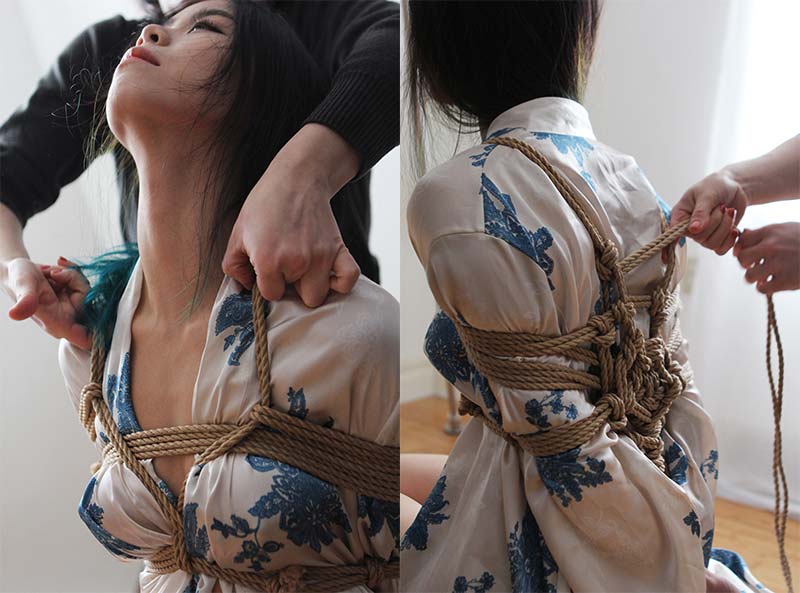
Primarily, Japan is quite conservative. You will see older generations who are still very traditional and quite closed minded.
However, connecting to that conservatism is this plethora of some of the most radically sexualised pockets of Japanese culture. Somehow, they all seem to intertwined much like the rope that is used to connect people and give a person a sense of sexual freedom.
What is Kinbaku?
Kinbaku means tight binding while Kinbaku-bi literally means “the beauty of tight binding”. It is a type of Japanese bondage or BDSM which involves tying a person up using simple yet visually intricate patterns.
This is usually done with several pieces of thin rope like jute, hemp, or linen. They are generally 6mm in diameter, but sometimes even as small as 4mm, and between 7-8 metres long.
Much like Shibari’s historical roots, the allusion is to use the hemp rope for restraining prisoners, as a symbol of power. This may be the same way that stocks or manacles are used in Western BDSM context.
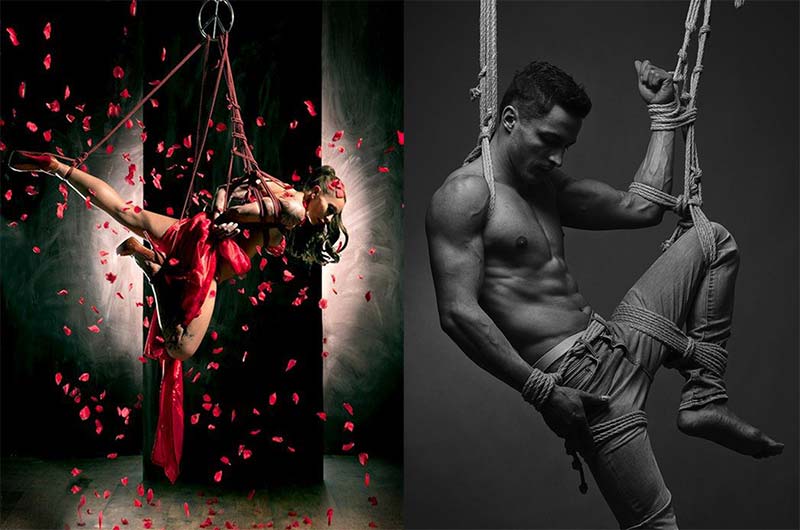
Origins of Kinbaku
Seui Ito is generally considered one of the fathers of contemporary Japanese rope bondage and used the terms in the 1950s.
Bondage as a sexual activity was first noticed in Japan in 1603-1868 during the late Edo period. Though it is noted that Seui Ito drew inspiration from other art forms of the time including Kabuki theatre and Ukiyoe woodblock prints.
Rise of Popularity
It became widely popular in Japan in the 1950s. Magazines such as Kitan Club and Yomikiri Romance published the first naked bondage photographs.
In the 1960s, people such as Eikichi Osada began to appear performing live SM shows often including a large amount of rope bondage.
Today these performers are often referred to as Nawashi which means “rope master” or Bakushi from the word Kinbakushi which means “bondage master”.
Kinbaku has become popular in the Western BDSM scene and has also profoundly influenced bondage. It has combined to produce many ‘fusion’ styles.
Kinbaku has gone mainstream!
You may have seen it in FKA Twigs’ “Pendulum” music video, where the singer was hanging by some seriously intricate hair braids.
This style of bondage uses specific rope patterns, many of which are based on Hojōjutsu ties. They have been modified to make them safer. Some Hojōjutsu ties were actually meant to harm prisoners, so they’re definitely not suitable for erotic use.
One of the most popular Kinbaku ties is the Ushiro Takatekote, which wraps around the chest and arms.
And did you know that the Ebi tie, also known as the “Shrimp,” was originally used for torture during the Edo period? Yikes!
Like other forms of BDSM and eroticism many of Kinbaku’s roots stem from corporal punishment and medieval torture techniques.
Over many years they have been carefully deconstructed and modified to make welcomed additions to the BDSM culture and sexual lifestyles.
This artful rope bondage is not only restricted to an exhibition both private and public. But you many also wear Kinbaku rope ties underneath clothing.
Wearing Kinbaku Rope Bondage under Clothing
Much like the Victorian corset it is hidden underneath clothing during the day. Depending on the certain tie, it can be used for pain relief in areas of the body.
Also it may form of restraint tied by a Dominatrix on his or her submissive counterpart to wear as a form of training, control and discipline.
Some will even wear these ties to assist with lifting breasts and offer more core support in some cases.
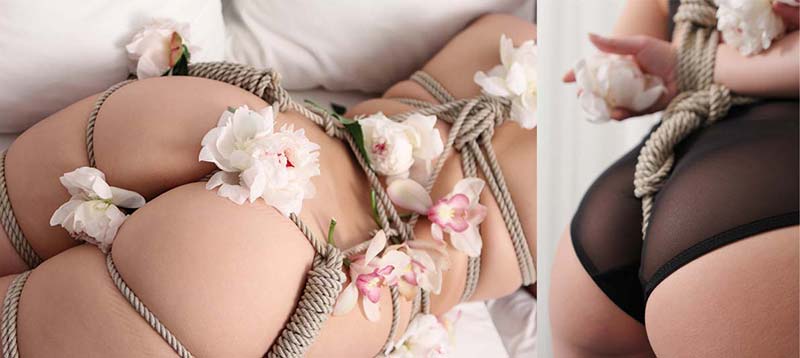
You can also incorporate sex toys, massagers, surgical steel anal hooks, and flowers which can all be interlaced with the tying too.
It adds another element to the general Kinbaku or Shibari play. This is very popular mostly for aesthetics. But it still adds a different feel, look and experience.
I highly recommend everyone at least try this unique form of bondage once, which is very easy to learn and very fun to try!
You can check out tutorials on YouTube which may ignite a new-found addition to your personal erotic repertoire.

Meet Bronte, our sexpert at the Adultsmart blog. A pansexual cis woman, she dives into LGBTQ+ topics, fetish exploration, sex work, and sex toy reviews!

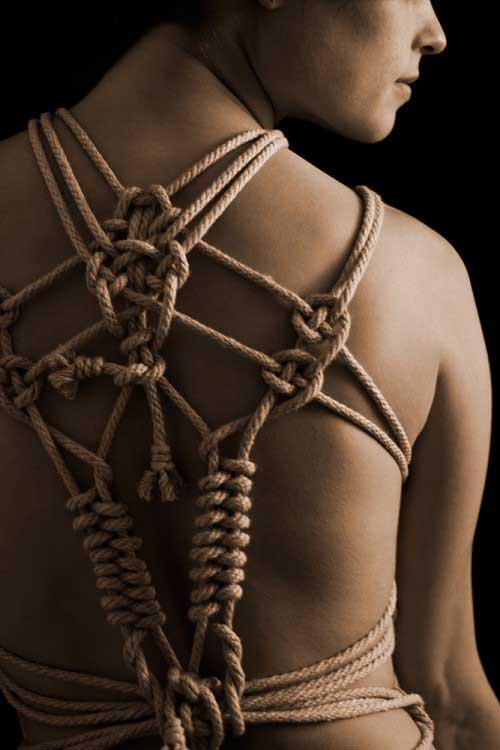






Leave a Reply